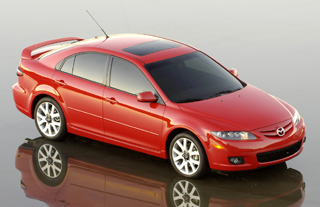
LOS ANGELES – How do you take a well-styled, and consequently well-regarded, vehicle lineup to the next level?
In the case of Mazda Motor Corp., the answer is: don’t dwell on the past.
“It’s been interesting for us to come onboard with Mazda and then to find out they didn’t say, ‘We’ve got a good thing going, don’t screw it up,’” Laurens van den Acker, Mazda’s new global design chief tells Ward’s in an interview here during the recent auto show.
“They said, ‘We’ve got a good thing going, but we’re looking at you guys to take the next big step.’ That’s very positive, I think, and very courageous.”
Van den Acker, general manager-Mazda Design Div., and Franz von Holzhausen, design director-Mazda North American Operations, both say that although Mazda has received critical acclaim for the styling of such models as the Mazda6 midsize sedan and Mazda3 compact car, the Japanese auto maker cannot rest on its laurels for fear of messing with a winning formula.
“You need to continue to evolve or you become obsolete,” says von Holzhausen. “If Audi (AG) still created Bauhaus (a 20th Century German design movement known for its straight edges and slim forms), and everybody’s trying to capture this Bauhaus feel, they wouldn’t (still) be at the forefront of (automotive) design.”
Both von Holzhausen and van den Acker spent time at the German luxury auto maker before coming to Mazda.

In the case of the Mazda6, which van den Acker considers a bellwether for the brand and the catalyst for its most recent global revival, he promises the next generation, reportedly due in the U.S. as an ’08 model, will have a stronger design personality and more character.
“It put us on the map, and it was the first sign (that) what we promised we could actually deliver,” van den Acker says. “The promise is a timeless thing. We will always do ‘zoom-zoom’ cars. But the way you express it has to be updated and made contemporary.
“I think what you’re seeing, too, is Mazda becoming more confident,” he continues. “We had some early successes, and now we want to capitalize on it and just add our own unique design language to it.”
Van den Acker replaced Moray Callum as Mazda design director in May when Callum was called back to Michigan from Japan to oversee Ford Motor Co.’s North American car design. Ford has a 33% stake in Mazda.
Under Callum, the Mazda brand began its recovery and climbed, in the words of van den Acker, from “zero to hero.”
The way he approaches Mazda design is very different from Callum, van den Acker says, precisely because the brand already is in a healthy state thanks to his predecessor’s focus on creating a family feel for all the brand’s models.
“The way he found Mazda is so much different to the way I find Mazda,” he says of the lack of design cohesiveness that plagued Mazda’s vehicles when Callum came on board in late 2001.
Callum would be challenged at this point, too, though, van den Acker admits.
“Even Moray would have had to change his ways to make the second big step,” he says, adding all Mazda design studios worldwide are working together, “pushing each other up” to create next-generation versions of its most successful cars.
“Now we need to take (the brand) to superhero (status),” he jokes.



